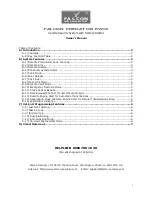
ENFORCER 300C/L
Installation Manual
ENFORCER 300C/L
Installation Manual
SECO-LARM U.S.A., Inc.
Page 8
Page 13
10. 6-wire connector, PURPLE WIRE
(positive door trigger input), fig. 6
(or to neg. external accessory, fig. 7)
This wire can be connected to positive door
triggers, or to external accessories such as
spare tires or fog lamps, but not both. See
page 17 for programming this wire.
A. Existing pos. car door switches (fig. 6) —
Use a VOM meter to locate a wire (usually
in the driver’s kick panel) which shows
+12VDC when any vehicle door is
opened, and which is not +12VDC when
all the doors are closed. Connect to the
PURPLE WIRE.
B. Externally-mounted accessory (fig. 7) —
For external accessories such as fog lights
or spare tires, make sure the accessory is
grounded. Then connect the PURPLE WIRE
to the accessory so that the wire is always
grounded. If a thief removes the
accessory, that will break the ground
connection and trigger the alarm.
11. 6-wire connector, BLUE/WHITE WIRE
(neg. hood/trunk trigger input), fig. 8
A. If the vehicle has a trunk light — Use a
VOM meter to locate a wire which shows
ground with the trunk open, and which is
not ground with the trunk closed. Mount a
pin switch in the hood. Connect as shown
in fig. 8a. Don't forget the diode.
B. If the vehicle has no existing hood or trunk
switches — Mount a pin switch in both the
hood and trunk (see fig. 8b).
12. 6-wire connector, YELLOW WIRE
(ignition switch positive input)
Connect to a fuse or wire which outputs
+12VDC when the ignition key is in the ON
and START position, but not the ACC position.
This wire must be connected at all times
to
ensure proper arming and disarming, as well
as to operate the push-button switch for valet,
emergency disarm, and temporary disarm.
×
Alarm BLUE/WHITE wire (neg.
hood/trunk trigger input)
Trunk pin switch
Hood pin switch
+12VDC
Trunk light
×
Alarm BLUE/WHITE wire (neg.
hood/trunk trigger input)
Hood pin switch
Hood/trunk switch
Fig. 8 — BLUE/WHITE wire
8a For cars with trunk lights:
8b For cars without trunk lights:
Fig. 9 — Connect the starter disable
Ignition
switch
Starter
solenoid
Alarm WHITE
starter disable
output wires
×
Alarm PURPLE wire
(neg. external accessory
trigger input)
Fig. 7 — Connecting external
accessories
External spare tire
or other accessory
B. Set sensitivity:
(1) Adjusting the sensor control knob
affects both the 1st and 2nd stage
sensitivity .
(2) Test the pre-intrusion (1st stage) by
lightly shaking a set of keys once. This
should cause the siren to chirp but not
trigger. Adjust the sensitivity by turning
the adjustment knob clockwise (more
sensitive) or counter clockwise (less
sensitive).
(3) Next, test the trigger (2nd stage)
sensitivity by continuously shaking a
set of keys firmly inside the car. The
alarm should trigger.
(4) NOTE:
a. When trigger sensitivity is set to
minimum, the sensor cannot
trigger the alarm.
b.
With sensitivity set to maximum,
the sensor is very sensitive.
This may cause unnecessary
chirps and/or false alarms.
c. The glass-break sensor will not
trigger the alarm until 4 seconds
after the alarm is armed.
B. If the vehicle (such as a delivery van) has
no existing car door switches — Mount a
pin switch in every door you wish to
protect. Connect each switch to the BLUE
WIRE.
GRAY
(-) to lock, (+) to
unlock, 300mA max.
×
RED
+12VDC constant
output, 300mA max.
Unlock
wire
Lock
wire
Factory actuators
Factory switching relay
Factory lock/
unlock switch
Fig. 14 (power door lock/unlock) —
Neg. relay switch to factory actuators
&
BROWN
(-) to unlock, (+) to
lock, 300mA max.
×
BROWN
(-) to unlock, (+) to
lock, 300mA max.
×
RED
+12VDC constant
output, 300mA max.
Unlock
wire
Lock
wire
Factory actuators
Factory switching relay
Factory lock/
unlock switch
Fig. 15 (power door lock/unlock) —
Pos. relay switch to factory actuators
+12VDC
&
×
GRAY
(-) to lock, (+) to
unlock, 300mA max.
×
18. 3-pin connector
GRAY WIRE (ground output to lock,
+12VDC output to unlock)
RED WIRE (+12VDC output)
BROWN WIRE (ground output to
unlock, +12VDC output to lock)
Figs. 14 to 20
These wires let the alarm control the power
door lock/unlock systems of most vehicles
without external relays. However, one or two
relays may be required in some cases.
The alarm has a built-in timer which is pre-set
for 0.7 seconds. It can be programmed for
3.5 seconds — see page 17.
Types of door lock/unlock systems — At the
time this manual was completed, there were
seven common types of power door lock/
unlock systems in use:
A. Negative relay switching to factory
actuators (fig. 14) — The factory door lock
switch has 3 wires. One wire always
shows ground. The LOCK WIRE becomes
ground when the door is locked, and
sends a pulse to a factory relay to lock the
doors. The UNLOCK WIRE becomes
ground when the door is unlocked, and
sends a pulse to a factory relay to unlock
the doors. Most Japanese cars use this
system. THIS IS THE MOST COMMON
TYPE OF POWER DOOR LOCK SYSTEM.
×




























